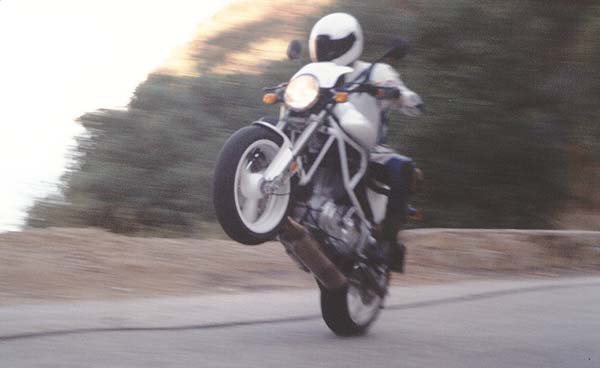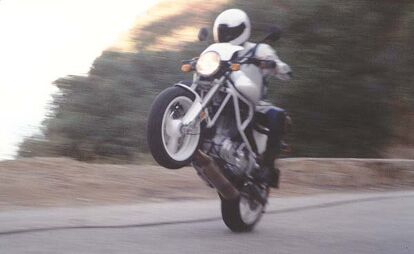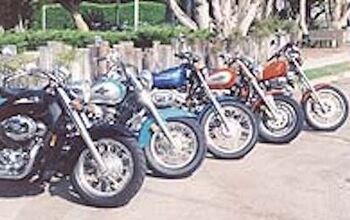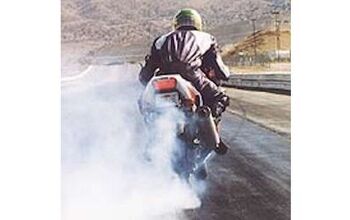Church Of MO – 1997 Open Bikini Shootout

Mr. Burns’ diary entry of the Top 10 sportbikes of the 1990s gave me a great idea for this week’s Church entry. If you want a taste of what old MO was all about, then the 1997 Open Bikini Shootout is a perfect example. Silly, irreverent, and filled with fast riding and fast riders, this test between the Buell S1 White Lightning, the Triumph T509 Speed Triple and Ducati’s M900 Monster, has it all: three cult classic motorcycles, one Shawn Higbee – an AMA Pro racer and former Buell test rider – and even a bikini model! Because, you know, a Bikini Shootout wouldn’t be complete without one of those. Check out the story (and the model), and don’t forget to click on the photo gallery for more pics.
1997 Open Bikini Shootout
LOS ANGELES, August, 1997 — They’re fast. They’re sexy. They’re impractical. They’re temperamental. They look great in a thong. They’re demanding, expensive and — if you’re lucky enough to climb on board — they’re a helluva lot of fun to ride. They’re the Bikini Bikes, and if you’re seen showing them off, be careful, because someone will try to steal them away. The staff at MO felt lucky, so we picked up a few hotties — an American bombshell, a cool Brit and a sleek Italian — with which to have our way. Three bikes: the Buell S1 White Lightning, the Triumph T509 Speed Triple and Ducati’s M900 Monster. One 45-degree pushrod twin, one 90-degree desmo twin, and one twin-cam in-line triple. Each bike claims king in different areas of style and design. Each bike sets standards in unique arenas of attitude and sound.
These are discriminating bikes for discriminating riders. If you’re looking for a long-term stable relationship, look elsewhere. However, if you’re looking for a really good time, give these bikes a call. They’re built for wild, hormone-fueled flings around town and through canyons — not for long distance, easy-going day trips to the in-laws. Only real players would choose one of these bikes as their everyday transportation. As enamored as we were, we had to put these bikes through the paces to determine which beauty was most worthy of our affections. Putting them into as many positions as we could handle, we worked them out at the Los Angeles County Raceway.
We even had the gumption to violate blue laws and transported them across county lines for illicit purposes.
In all, for four weeks in California’s fine August weather, MO ruled the streets of L.A., terrorizing pedestrians, popping wheelies, burning rubber, trying to pick up dates and strafing curbs.
All in the name of complete and accurate reporting, and with a clear goal in mind: If you’re a deviant, what’s the best bike for you?
Mind you, going into this Shootout, each MO staff member had his own favorite. First impressions are important, but you never really get to know a bike until you spend time with one. The results of our Shootout surprised us. It may surprise you as well.
1997 Ducati M900 Monster
MO racer Shawn Higbee liked the Monster’s snap out of corners. Ducati’s Monster comes into this test as the reigning champion of last year’s Muscle Bike Shootout. After this little bike’s impressive showing against the brawn of last year, you’d think it would manage better than bottom rung against this year’s bikini models, but this was not to be.
We started the Duc off with some commuting and around-town terrorism. The Monster’s soft suspension soaked up all the bumps and patchwork irregularities of L.A.’s urban sprawl, and even helped the Monster land reasonably well when a particularly large ripple helped get the bike airborne. Its light weight and generous torque made the M900 ideal for tossing around through city scenes, but we disagreed as to which bike was better at dealing with traffic congestion and horrid pavement; some sided with the Buell due to its higher-quality suspension that’s more firmly sprung, while others stuck with the Ducati. Either way, both are better in an urban environment than the bulkier Triumph.
1997 Triumph T509 Speed Triple
When it comes to Triumph, good things come in threes. Three cylinders, that is. Speed Triple. And what a sound those three inline cylinders emit: A raspy, throaty yowl with musical qualities that are unmistakably British, and characteristically Triumph.
Speed Triple’s appearance is striking, to say the least. Triumph’s 1997 version of its Speed Triple, the T509, has been vastly improved over the previous model — a bike that flunked miserably in last summer’s Muscle Bike shootout. Gone are the imperfect qualities that relegated it to also-ran in that comparison — poor suspension setup, weak, tubular spine-type steel frame, weird riding position and antiquated Michelin Hi-Sport tires.
Changes to the ’97 Speed Triple echo improvements found on Triumph’s excellent T595 Daytona, including the all-new oval-section aluminum frame and a lighter, more compact version of the 885cc three-cylinder motor.
T509’s single-sided swingarm is one of its most appealing features.
The Speed Triple’s engine also received a new Lotus-designed top end with bigger valves and new cams, as well as a Sagem Electronic Fuel Injection (EFI) system that is capable of three million instructions per second. The EFI’s black box can also be remapped to match aftermarket performance upgrades an owner may add down the road, such as an exhaust system.
Brakes on the T509 were linear and strong, and were voted best among the lot.The quality of the new engine’s power delivery is every bit as important as its quantity. Problem is, it takes lots of revs to find it. Below 4500 rpm, there simply isn’t any, a problem exasperated by what we figured was a faulty EFI map that periodically stalls the bike and feels much too lean off the line. Anyway, the triple begins its climb into its power zone around 5000 rpm, then pulls smoothly and briskly to its peak of 88.2 horsepower at 8750 rpm (only .30 hp shy of the White Lightning), with an extremely flat torque curve.
The T509’s lack of low-rev punch hurt it in top-gear roll-on testing, where both twins spanked the Triumph. In dragstrip testing the Triumph suffered from the worst launches — a combination of vague clutch and poor EFI map — but squeaked by the Ducati with its 18 additional top-end ponies. Out on the open road, the Speed Triple wasn’t quite as fast as the Buell in top-speed testing, but its funky little quarter fairing/thong offers much better wind protection — anything over 125 mph on the Buell, and you’d better hang on and stay glued down on the tank.
Not so on the Triumph, which has a nice, still pocket of air behind its bikini fairing. While not as large or as aesthetically pleasing as the Ducati’s bikini, the T509’s wind-tunnel-tested flyscreen acts as a “triumph” of function over form. All told, in the mischievous environment of stoplight-to-stoplight boulevard bruising, bragging rights clearly fall with the Buell. Hop aboard the T509 after jumping off one of the twins, and you’re instantly impressed with the comfort of its seating position, by far the best of this bunch for distance riding. Its higher seat height gives tall riders a lot of leg room, and the reach to its flat, tubular handlebars is also suited for longer arms.
This Speed Triple loved to be ridden hard, and in twisty background bashing its fully adjustable Showa suspension, grippy Bridgestone BT56 rubber, light, neutral steering and perfect seating position made it the most sport worthy of this bunch for most riders, though our racers on staff preferred the Buell’s quick steering and torquey off-corner acceleration.
Need to stop? Quickly? The general consensus of our staff was the Triumph came equipped with the friendliest brakes, though we encountered a problem here, too. Its front 320mm floating discs and four-piston Nissin calipers rapidly haul it down from speed with great lever feel and control, although the brakes did become grabby after repeated hard use on a hot summer day.
Did you say something about the T509’s looks? Triumph’s distinctive bug-eyed dual headlights inspired both praise and groans. Luckily a more traditional single headlamp option is available in the U.S.
Our main concern with Triumph’s new Speed Triple lies with its reliability. In some ways, it doesn’t have a well-sorted feel. We encountered troubles with the fuel injection system (sputter) and engine driveline (clunk) while testing the 509, and our test unit completely expired while street riding, leaving us with a bittersweet taste after recalcitrant fuel injection, touchy brakes and a blown motor ruined our test schedule.
Subsequently, the local fleet center/dealer (most manufacturers have dedicated fleet centers, Triumph and Ducati give incentives to dealers who perform this duty — Ed.) was less than helpful and appeared to be less than truthful about what really blew up. Was it truly ready for production? Hard to say, but unlike Triumphs of the past, the T509 and T595 are pushing performance and technology envelopes in a way the British firm has never done before. Although not perfect, the 1997 Speed Triple was sure fun to ride, and our overall impression of the company is that, while they seemingly don’t have their act together in the USA (repeated calls to Triumph’s importer went unanswered), the corporate philosophy is decidedly customer-driven and reliability oriented; we hope we just got a bad apple.
Specifications
Manufacturer: Triumph
Model: 1997 T509 Speed Triple
Price: $9995.00
Engine: Liquid cooled, DOHC in-line three cylinder
Bore and Stroke: 76 x 65 mm
Displacement: 885 cc
Carburetion: Sagem EFI, 41 mm throttle body
Transmission: 6-speed
Wheelbase: 56.6 in (1437 mm)
Seat Height: 31.5 in (800 mm)
Fuel Capacity: 4.5 gal (17.0 L)
Claimed Dry Weight: 432 lbs (196 kg) Measured Wet Weight, Tank Full: 486 lbs
Measured Horsepower: At The Rear Wheel: 88.2 @ 8750 Measured Torque, At The Rear Wheel: 56.5 @ 7750
1998 Buell S1 White Lightning
And so we come to this years’ Open Bikini Shootout winner: Buell’s new S1 White Lightning. Seemingly just a graphically revised S1, in reality the changes to Erik Buell’s latest jail bait are extensive and thorough, addressing every performance concern pundits and buyers alike mentioned last year.
From 12 percent more power to better brakes and improved handling, the new White Lighting is a vastly improved motorcycle compared to last year’s machine.
Note that we didn’t include comfort in the list of improvements — the seat still sucks. Badly. The first time you ride a WL, that’s plainly evident, but then again, so is the new engine configuration. In keeping with their natural disaster naming scheme, the new engine’s been dubbed the “ThunderStorm,” and ours pumped out 88.5 horsepower at the rear wheel and a whopping 76 ft-lbs of torque.
That’s roughly 10 more horsepower compared to the last generation Lightning, power that was found in completely redesigned cylinder heads and a new exhaust system.
“Both the intake valve and seat diameter are bigger,” says Gary Stippich, Harley’s engineer in charge of Buell powertrain development.
“The exhaust valve and seat are bigger as well, and the intake has a new port configuration matched to the valve. The exhaust port is new too, with the main difference being that the outlet to the pipe is smaller than previous years’ designs.
Buell’s White Lighting out-accelerates and has a higher top speed than either the Duck or T509
There’s a couple reasons, one is to keep high velocity in the port, but the main reason is because the gasket is the same diameter as the old port, and over time the gasket would crush and stick in the port, robbing power. With the new port closed down a little, the gasket is shielded from hot exhaust temperatures, which helps it hold its shape.” Flow was also gained in the cylinder heads by unshrouding the valve seats.
This added two or three cubic centimeters to the heads, so Stippich designed a set of domed pistons (S1 pistons, taken directly from 1200cc Sportster motors, are flat-tops) that reclaim about 6.5cc.
Thus the new WL has marginally higher compression than last year’s — 10.2 to one versus 10.0, respectively. (For various reasons, this isn’t printed in any of the brochures or specifications put out by Buell.) Add into the equation a race-bred 2.5-inch exhaust system collector and 2.5-inch muffler inlet — up from 2.0 inches last year — and there’s all of your power gains for this year.
And that translates into the fastest bike in this test: The White Lightning posting an 11.59 second run at 115 mph on a blistering, 100-degree summer day at Los Angeles County Raceway. In any sort of roll-on comparison the Buell squirts away, though it just barely edged Triumph’s T509 in top-speed testing. Let’s say you twist a big handful of throttle and cook too hot into a turn.
Better be careful! If you’re used to Buell’s old Performance Machine sponge-o-matic brake caliper with long-lasting but relatively weak Ferodo 901-compound brake pads, you’re in for a big surprise: The new Nissin six-piston caliper and sintered metal pads bind with amazing force to a huge stainless steel 340mm brake rotor. Initial bite is the strongest in this test, despite only having a single front rotor — both the Duc and Triumph have dual 320mm floating rotors.
Buell racers had been calling for more high-speed rebound front and rear for better control over bumps at speed, so Buell’s engineers revalved the fully adjustable WP front forks and rear shock. These improvements have paid off: The leather-clad, knee-draggin’ enthusiasts amongst our staff adamantly picked the Buell as the best-handling bike. And in this arena its ultra-narrow seat is a benefit, allowing the rider to quickly move side-to-side and back-to-front on the bike, giving an element of control not available on the other machines.
When all was said and done and it came time to pull those bikini strings and vote the Buell’s rock-solid reliability — we didn’t have one problem with the White Lightning — was a big plus. Add in its performance advantage and top-quality suspension, and you’ve got a clear winner — the best of Motorcycle Online’s 1997 Open Bikini bikes.
Specifications
Manufacturer: Buell Model: 1998 S1 White Lightning
Price: $10,599.00
Engine: 4 stroke 45 degree V-Twin
Bore and Stroke: 3.5 x 3.8 inches
Displacement: 1203cc
Carburetion: One Keihin 40 mm
Transmission: 5 speed
Wheelbase: 55.0 in (1397 mm)
Seat Height: 29.5 in (749 mm)
Fuel Capacity: 5.5 gal with .6 gal reserve
Claimed Dry Weight: 425 lbs (184 kg) Measured Wet Weight, Tank Full: 460 lbs (209 kg)
Measured Horsepower: At The Rear Wheel: 88.5 @6300 Measured Torque, At The Rear Wheel: 76.0 @5800
Open Bikini Shootout Conclusion to the Catfight
While Buell’s S1 White Lightning was the decisive winner of MO’s Bikini Bike Shootout, this would’ve been a very close test if Triumph’s T509 had been more reliable. In fact, all three are very good bikes and are comparatively priced, with less than 800 dollars separating the most expensive from the least. As such, personal tastes are bound to factor. If you’re looking for comfortable ergonomics, the Triumph is your ride. If you prefer wheelie-popping torquey power, the White Lightning will kick your ass. If you’re leaning to an all-around bike, fun to ride in both the city and country, Ducati’s Monster is your Frankenstein. It’s important to point out that amongst our staff only two voted the same way, and although no one picked the Monster first, we’re open
to arguments why the Duc should be number one.
Open Bikini Dyno Charts
Open Bikini Shootout Girls Kick Ass: Notes From The Better Half By Jane Galliano, Contributing Writer
After a couple hours of watching racer Shawn Higbee and Editor-in-Chief Brent Plummer flog the three Bikini Models into submission at LACR (I know what you are thinking, and it just ain’t what happened), I was asked if I wanted to take a crack at drag racing. I’ve got a lot of street miles in the years I’ve been riding, but no actual racing. Male egos swarmed that day — Higbee and Plummer were getting intense about who’d be fastest, like it wassome sort of manly ritual to be fastest on each
bike, every time. It was quite amusing, especially since they both pretend like they didn’t care.Anyway, while the boys shrugged and giggled, I mounted up on the White Lighning — it’s the only bike I felt comfortable doing dangerous things (like wheelies) on since it’s got the lowest seat height, and the saddle is very, very narrow: Standing only 5’3″ tall, I can reach the ground on the Buell without sliding off to one side and balancing the bike under one thigh. The Ducati was close, but the seat is wide and stands over 30 inches off the ground. If you’re short, forget about the Triumph — the seat is both high (31.5 inches!) and really wide, with hard, square edges that I found quite uncomfortable.
“Once saddled up on the Buell, I ripped off a run that would make my father proud – 13.038 second quarter-mile at 109 mph.”Silence. Two runs later I was down to 12.443 at 109 mph. The remaining staffer-boys who had previously planned on making runs were now looking anxiously at their watches and asking if maybe we weren’t running late. Ha! Nobody followed me down the strip.
Overall, the White Lightning made my respectable runs pretty easy. Considering the astounding torque produced by the new engine, I should’ve known it’d instantly wheelie off the line, but I wasn’t prepared and let out a healthy scream at the 30 foot mark — of course the guys won’t let me forget it. After all, there’s no screaming in drag racing, right?
“That was really fast!”
“Yeah, I think I’d like that” Jane’s fastest run was less than a second off the outright fast time, and only .44 off the Ducati’s best. (Girls get big egos too.)
Mike “My mom will kick yer mom’s ass” Belcher and Mark “My foot hurts” Hammond try to hang out with the real drag racers. Photo by Billy “It’s past my curfew” Bartels. (From left to right: Galliano, Plummer, Hammond, Belcher, and Higbee.)
Los Angeles County Raceway
Once again we packed up the magazine and headed out to Los Angeles County Raceway’s scorched quarter-mile pavement for another day of clutch-frying fun. Triumph’s T509 was ailing from some fuel injection problem that was causing it to stall at idle, so we trucked it up in our support vehicle.
In the past we had grown accustomed to clutches going a little soft after a day at the park, but actually killing one was somewhat rare. Well, the Monster set a new record: 12 runs and it was toast, so we had to return in the support truck. Magically though, the Speed Triple got over its idling problem. Weird.
Plummer posted fast times on all three bikes, best on the T509 was a 11.782 at 115.731 mph.
And we just thought he needed a date: Editor Plummer’s hump-the-tank and kiss-the-tach with minimal frontal lift style looked odd, but worked this day. Plummer posted fast times on all three bikes, best on the T509 was a 11.782 at 115.731 mph. M900 Monster turned a best of 11.97 seconds at 109.11 mph before giving up its clutch in the effort. Buell’s new fire-breathing S1WL clocked our best time of the day: 11.597 seconds at 115.178 mph.
Santa Ysabel
Santa Ysabel Valley northeast of San Diego is the center of ranchlands that include thousands of miles of (mostly) clean, twisty asphalt, with some wide open stretches thrown in for good measure.
This is a land of rugged beauty and plenty of cows, with four-wheeled motorcyclist killers infrequently showing to spoil the fun. This is also the site of the T509’s demise. During a top gear roll-on test on the road shown above, it suffered valve train failure and had to be trucked back to L.A. Ultimately, this proved to be our most telling proving ground for the Bikinis.
Malibu Canyon
Shawn Higbee walks into the Motorcycle Online offices one fine morning and exclaims, “I found a killer spot to take photos. It’s only open to local traffic, so the chances for getting run over are slim.”
After following the racing madman up some twisted backroads above Malibu Beach, we became convinced he was trying to lose us so we couldn’t find our way back here again.
After all, a pro racer’s training grounds are sacred places.
Though we could see the outskirts of Santa Monica in the distance, we had no idea how we came to this place, and Higbee wasn’t talking — just ridin’.
The Bikini Babe:
When the Open Bikini Shootout was proposed a few months ago, we instantly had a picture in our dirty little minds how the homepage should look for such a comparo. After all, how can you have an Open Bikini Shootout without an, umm, open bikini?
Proposals are one thing, finding just the right chest to sport the open bikini was quite another. Being the computer geeks we are, we don’t know many women (except the kind that kicks our asses at the dragstrip). So the search was on. We located our bikini babe a scant two weeks before the story was posted (and almost a week after the Triumph blew up) at (what else?) a bikini contest in Hollywood. So give thanks to our babe, otherwise you’d be reading another “Roadster Shootout,” “Hooligan Duel,” “Neo-Standard Hell-Raising Slaughterhouse,” or some other similarly cliched drivel…
“Boys?”
“Duh.”
“Marry me.”
“That should be alright, what to you think Mark?”
“Yes, that would be acceptable.”
“There’s our Homepage!”
Specifications
Manufacturer: Mom/Dad/Dow Corning
Model: Blonde Babe
Year: She wouldn’t say
Engine: Big Twin
Bore and Stroke: “It says ‘stroke'”
Displacement: Curvy
Carburetion: Naturally aspirated
Transmission: No
Seat Height: 32 in (36 in pumps)
Fuel Capacity: We don’t kiss and tell
Claimed Dry Weight: 105 lbs Measured Wet Weight, Tank Full: 121 lbs
Measured Horsepower: At The Rear: Yes
Measured Torque: At The Rear: Ditto

Troy's been riding motorcycles and writing about them since 2006, getting his start at Rider Magazine. From there, he moved to Sport Rider Magazine before finally landing at Motorcycle.com in 2011. A lifelong gearhead who didn't fully immerse himself in motorcycles until his teenage years, Troy's interests have always been in technology, performance, and going fast. Naturally, racing was the perfect avenue to combine all three. Troy has been racing nearly as long as he's been riding and has competed at the AMA national level. He's also won multiple club races throughout the country, culminating in a Utah Sport Bike Association championship in 2011. He has been invited as a guest instructor for the Yamaha Champions Riding School, and when he's not out riding, he's either wrenching on bikes or watching MotoGP.
More by Troy Siahaan
















































































Comments
Join the conversation
Nice dual headlights. The Speed Triple isn't bad either.
Make America Great Again, Bring back the biker babes!